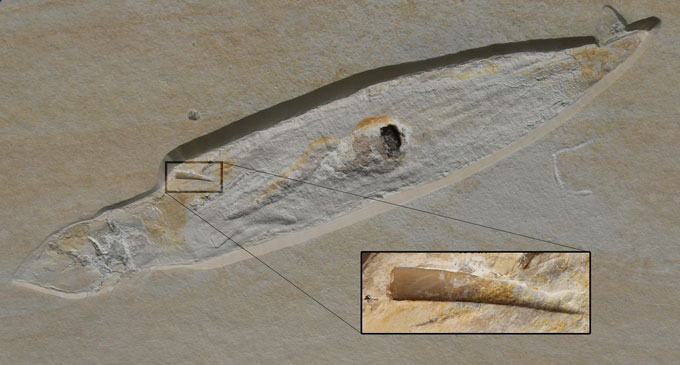A fossil of a squid with a pterosaur tooth embedded in it offers extraordinary evidence of a 150-million-year-old battle at sea. While many pterosaur fossils containing fish scales and bones in their stomachs have revealed that some of these flying reptiles included fish in their diet, the new find from Germany is the first proof that pterosaurs also hunted squid.
The fossil was excavated in 2012 in the Solnhofen Limestone, near Eichstätt
in Bavaria, where many Jurassic Period fossils of pterosaurs, small dinosaurs
and the earliest known bird, Archaeopteryx, have been found. The region’s environment at the time was
something like the Bahamas today, with low-lying islands dotting shallow
tropical seas.
The embedded tooth fits the right size and
shape for the pterosaur Rhamphorhynchus, paleontologists
report online January 27 in Scientific Reports. They argue that the tooth was left by a pterosaur that swooped
to the ocean surface to snap up the 30-centimeter-long squid from the extinct Plesioteuthis genus, but was unsuccessful,
possibly because the squid was too large or too far down in the water column for
the predator to manage.
“The Plesioteuthis squid wrestled it off and escaped, breaking at
least one tooth off the pterosaur, which became lodged in [the squid’s] mantle,”
says Jordan Bestwick, a paleontologist at the University of Leicester in England.
“This fossil is important in helping us understand the dietary range of Rhamphorhynchus,
and tells us about its hunting behavior.”

The fossil itself is unique, according to pterosaur
researcher Taíssa Rodrigues at the Federal University of Espírito Santo in Vitorio,
Brazil, who was not involved in the study. “It is very rare to find predator-prey
interactions that include pterosaurs,” she says. “In the few cases we do have,
pterosaurs were the prey of large fish. So it is great to see this the other
way around.”
Paleontologist Michael Habib of the
University of Southern California in Los Angeles says he suspects the squid was
far too large for the pterosaur to haul out of the water. “The pterosaur was
lucky that the tooth broke off,” says Habib, who was not involved with the
study. “A squid of that size could probably have pulled it under.”
